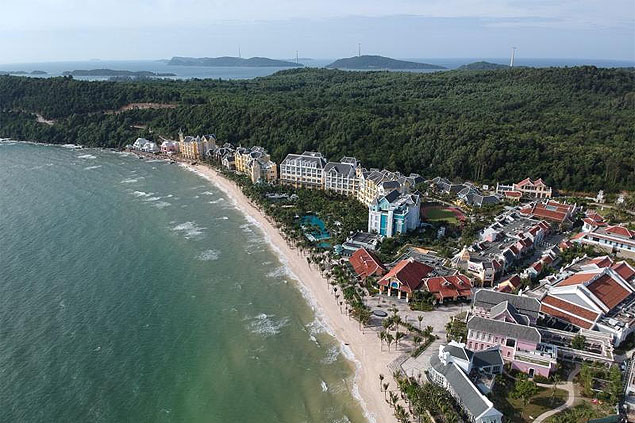
Vietnam is looking to replicate Phuket in putting its largest island in the Gulf of Thailand on the global tourist map.
The teardrop-shaped Phu Quoc, just slightly larger than the southern Thai resort island, is relatively new to tourists outside of Vietnam.
The infrastructure on the island, with its north coast only 15 kilometres from Cambodia, is certainly far less developed than that on Phuket, which is likely a selling point for some foreign tourists to the island.
But Phu Quoc has been undergoing a fast and furious transformation, with the development of tourist-related infrastructure moving at what several hoteliers described as a "maddening" speed, similar to Phuket several decades earlier.
Phu Quoc is racing against time to emulate the success of Phuket in attracting mass tourism, particularly high-end international holidaymakers.
Local officials said there are more than 250 projects valued at over US$14 billion in the pipeline. That massive outlay includes the development of a new international airport, whose first phase recently opened for commercial flights.
Only a few years back, Phu Quoc remained largely a sleepy historical backwater of Vietnam with scant infrastructure for international travellers.
The opening of two international chain hotels on the island last year -- JW Marriot Phu Quoc Emerald Bay and the Spanish hotel chain Melia's Sol Beach House Phu Quoc -- has led the transformation.
Towards the end of 2015, the first phase of a zoo with 3,000 animals and 150 species, operated by Vinpearl Safari Phu Quoc, was opened to the public on the northern side of the island.
Hospitality development on Phu Quoc is booming, with some eight international brand hotels and resorts, including Thailand's Dusit International group, set to offer more than 3,800 new rooms over the next 3-4 years.
Such growth is too fast to match the actual demand and pace of supporting infrastructure, said Raul Mateo, general manager of Sol Beach House Phu Quoc.
There is already a glut in hotel rooms on Phu Quoc, with 45-50% of the 10,000 rooms currently available occupied, Mr Mateo told the Bangkok Post.
But there is a strong sense of optimism among property developers and the tourism industry in general about the outlook of Phu Quoc being elevated as a new island resort in Southeast Asia.
Billions of dollars in investment has been poured into tourist infrastructure, including a 27-hole golf course, a casino and an eight-km cable car linking the main island with the smaller Hom Thom Island.
Local government officials said hotels are being built in Phu Quoc to prepare for as many as 3 million visitors a year by 2020, up from 1.45 million recorded last year, with 14% of them foreigners, mostly from Europe.
Vietnamese officials are keen to position Phu Quoc alongside Phuket and Bali, as Vietnam has put overall tourism promotion high on its national agenda.
According to Vietnam's Government Statistics Office, international visitors to the country as a whole rose 28.4% in the first nine months of this year to 9.44 million. Some 7 million of those visitors were from Asia, over half of them from China and South Korea.
Last year, the overall number of international arrivals to Vietnam exceeded 10 million, up 26% year-on-year.
By 2020, the socialist state targets tourism to generate $35 billion, contributing an estimated 10% to GDP.
The introduction of a visa waiver policy for foreigners visiting the island for up to 30 days is being used to draw foreign visitors to Phu Quoc.
Meanwhile, the island was christened a special economic zone by the Vietnamese government to help propel development and create a platform to drive its tourism agenda.
Vietnamese planners have set an ambitious economic growth target for Phu Quoc at 25-30% a year.
INTERNATIONAL AIR LINKS
Current international flight connections with Phu Quoc are regarded by international industry executives as being too few to raise arrival numbers to the island at the speed they want to see.
There are a few charter flights operated by tour service companies like Tui Travel that ferry holidaymakers from Europe to Phu Quoc, mostly during the winter season.
International airlines serving Phu Quoc include China Southern and Jetstar Pacific, which is majority-owned by flag carrier Vietnam Airlines.
Vietnam's low-cost carrier VietJet and Vietnam Airlines operate frequent daily services from mainland Vietnam to Phu Quoc.
Phu Quoc's tourism industry hailed Bangkok Airways' recent launch of non-stop service between Bangkok and the island as a boon to tourism promotion plans.
"More direct and frequent air links with Bangkok will be a key driver for Phu Quoc's tourism scene because the Thai capital is a de facto air hub in this region, said Melia's Mr Mateo.
Bangkok Airways commenced regular flights from Bangkok's Suvarnabhumi airport to Phu Quoc on Oct 29 with four flights a week on an ATR72-600 turboprop with 70 seats.
Bangkok Airways became the first carrier to directly link Phu Quoc with the Thai capital.
Bangkok Airways aims to feed international passenger traffic to Phu Quoc from long-haul flights operated by its 24 code-share partners, including Air France, KLM and British Airways, which have connecting flights at the Suvarnabhumi base.
Varong Israsena, vice-president for sales at Bangkok Airways, said initial response to its Phu Quoc service is encouraging, with an average of 70-80% of seats on each flight taken.
Puttipong Prasarttong-Osoth, president of Bangkok Airways, said there is potential for the airline to increase the frequency of its service to Phu Quoc or even deploy higher-capacity aircraft on the route over the next year.
Industry executives said Phu Quoc has a long way to go before reaching parity with Phuket, but Vietnam has shown a willingness to put in the work.